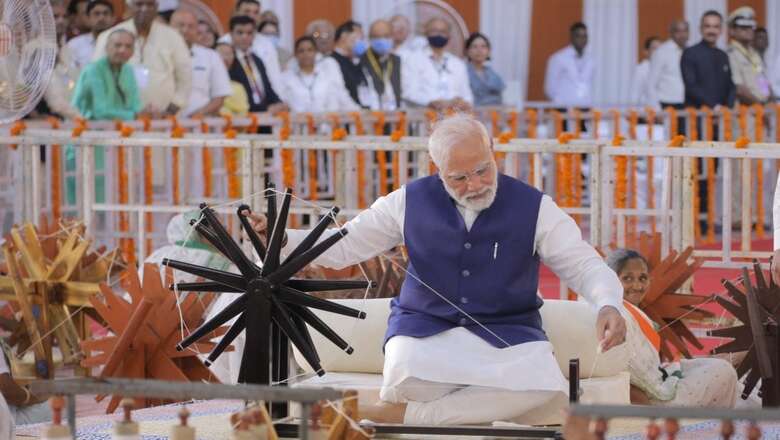
views
“Many foreign-made objects have encroached on our lives and getting rid of them is important for saving the country” — This was Prime Minister Narendra Modi’s message to more than 3,000 students from various colleges and universities at the G20 University Connect Finale event recently. PM Modi has called on India’s youth, especially students, to make Khadi clothes a fashion trend, and for colleges and universities to emerge as hubs for the ‘Vocal for Local’ movement.
The Rise of Khadi Sector Since 2014
The Khadi industry has seen incredible growth over the past nine years, and credit for the same goes to the Modi government. A series of initiatives with the end goal of complementing the ‘Make in India’ and ‘Vocal for Local’ missions have been rolled out over the past nine years. Here are some more fascinating numbers.
- In the last fiscal, India’s Khadi and village industries set a record. For the first time since independence, the turnover of the Khadi and Village Industries Commission (KVIC) crossed Rs 1.34 lakh crore. Just to put this figure in perspective, the turnover of KVIC in 2013-14 was a mere Rs 31,154 crore. Since 2014, there has been a whopping 332 per cent rise in the sale of indigenous Khadi products made by artisans in rural areas.
- In FY 2022-23, the production of Khadi and Village Industries products has increased by 268 per cent to reach Rs 95,957 crore, compared to Rs 26,109 crore in FY 2013-14.
- Production of Khadi clothing stood at Rs 811 crore in FY 2013-14. Today, it has grown by 260 per cent to reach Rs 2,916 crore.
- In FY 2022-23, the sales of Khadi and Village Industries products reached Rs 1,34,630 crore, registering a 332 per cent increase from the Rs 31,154 crore sales that were registered in FY 2013-14.
- Meanwhile, sales of Khadi clothing increased by 450 per cent to reach Rs 5,943 crore in FY 2022-23, compared to Rs 1,081 crore in FY 2013-14.
- Khadi and Village Industries Commission has achieved another important laurel – of creating jobs. The KVIC has created more than 9.5 lakh new jobs in rural India in the last fiscal. Compared to 2013-14, that is a growth of 70 per cent.
- Workers involved in the Khadi sector have also seen their incomes increase as both production and sales of Khadi clothes expand. Since 2014, their remuneration has increased by more than 150 per cent. Moreover, as of April 1, 2023, the wages of Khadi artisans have been further increased by more than 33 per cent.
Efforts have been made to rebrand Khadi as a fashionable and contemporary fabric. Some of the steps taken to strengthen the Khadi industry include:
- Rebates on Khadi products have been replaced with the market development assistance (MDA) scheme since April 1, 2021. Under MDA, 25 per cent of assistance is given to spinners and weavers as an additional incentive.
- KVIC has been collaborating with various government departments like railways, defence, and health & family welfare to increase the sale of Khadi and village industries products.
- The government is also utilising KVIC to boost Khadi sales by selling products through a network of outlets, an online portal, and participating in events like IITF 2022 and Lakme Fashion Week.
- Social media is being used to drive Khadi sales and promote it as a contemporary fabric. Initiatives, discounts, and collaborations with NIFT for design development are also in place to further support the growth of Khadi products.
- 12 young designers from the International Institute of Fashion Design (INIFD) showcased Khadi clothes at the London Fashion Week earlier this year.
In an effort to further popularise Khadi internationally, Prime Minister Modi used the G20 Summit as a forum to present Khadi shawls to world leaders. The PM himself frequently dons Khadi attire — like jackets and kurtas. In fact, in August, PM Modi tied the usage of Khadi products to an individual’s self-respect. He said, “This ‘Khadi’ is not just a piece of cloth but also a weapon for those with self-respect, who are proud of the nation, and who dream of Aatmanirbhar Bharat.”
There is much talk today about reducing humanity’s carbon footprint. At an individual level, Indians can join this mission by starting to use Khadi fabric more often. A major challenge faced by the Khadi industry is adoption. A lot of Indians even today are unwilling to accept Khadi as their go-to clothing choice. Khadi’s true potential can only be unleashed if Indians make Khadi clothes their primary choice. Khadi fabric is skin-friendly. It keeps the body cool in summer and can absorb moisture and sweat. Khadi fabrics can also keep the body warm during winter.
The spinning of Khadi uses no machines or energy and thus has a low carbon footprint. A metre of Khadi fabric consumes three litres of water, while one metre of mill-produced fabric uses 55 litres of water. Cherry on the topping, using Khadi clothes helps rural — usually underprivileged families — make a living. Extensive use of Khadi can become a collective exercise in the upliftment of lakhs of rural families. Above all, large-scale use of Khadi will give a big shot in the arm to India’s ‘Atmanirbhar’ mission.
It is no wonder then, that the PM has been a big advocate of the youth embracing Khadi goods. More Indians using Khadi goods would have a transformative impact on the economy, environment and livelihoods. It is time to turn Khadi into a global ‘brand’.
Views expressed in the above piece are personal and solely that of the author. They do not necessarily reflect News18’s views.




















Comments
0 comment